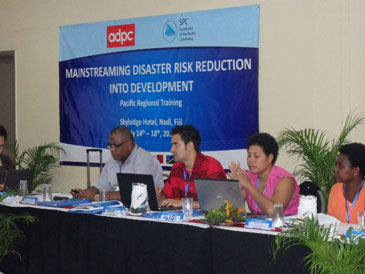
Pacific Island countries are amongst the most disaster prone in the region, exposed to natural hazards such as floods, droughts, tropical cyclones, earthquakes, volcanic eruptions and tsunamis, which all pose a significant challenge to development in the Pacific region. A single disaster event can result in losses in the millions of dollars and can undo progress in areas such as infrastructure, agriculture, healthcare and education.
Despite recognition of the importance of disaster resilient approaches to development, many countries face challenges in identifying ways to effectively mainstream risk reduction considerations into national development planning processes. To address this, the Secretariat of the Pacific Community, in partnership with the Asian Disaster Preparedness Centre is holding a one week training workshop which focusses on how to mainstream Disaster Risk Reduction into development.
The training, in Nadi from 14-18th July, includes participants from the Cook Islands, Fiji, Samoa, Solomon Islands, Tonga and Vanuatu with representatives of National Disaster Management Offices and ministries responsible for national planning and finance. Representatives from the Pacific islands Forum Secretariat, Secretariat of the Pacific Community, Secretariat of the Pacific Regional Environment Programme and United Nations Development Programme will also participate in the training workshop.
A mixture of theory, case studies and exercises will be used to increase participants’ knowledge and skills in areas such as risk assessment, understanding the links between development and disasters, selecting appropriate risk reduction options and identifying and entry points to mainstream risk reduction in development. The training workshop will further build capacities of government planning officials in the Pacific Region to plan and implement disaster resilient development through enhancing their understanding of the integration of Disaster Risk Reduction (DRR) considerations in the development planning process.
The training workshop is supported by the Asian Disaster Preparedness Centre and the Secretariat of the Pacific Community. The Asian Disaster Preparedness Centre (ADPC) works in a number of countries in the Asia Pacific region to strengthen disaster resilience at all levels. The Secretariat of the Pacific Community is an international organisation that works in public health, geoscience, agriculture, forestry, water resources, disaster management, fisheries, education, statistics, transport, energy, human rights, gender, youth and culture to help Pacific Island people achieve sustainable development.
For more information contact: Dr Kirstie Méheux, Senior Adviser Disaster Risk Management Training, SPC This e-mail address is being protected from spambots. You need JavaScript enabled to view it +679 9315 189





